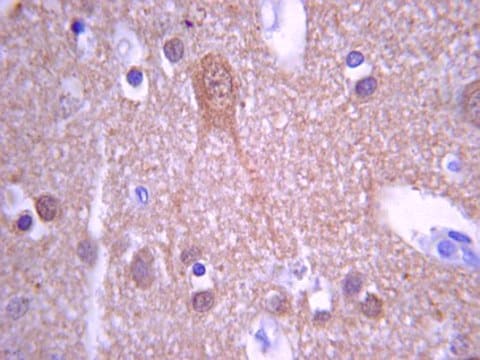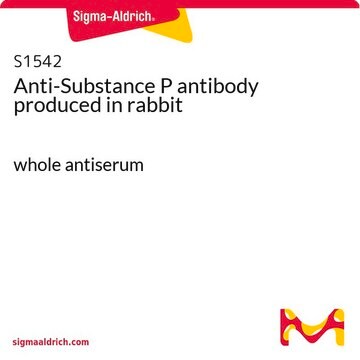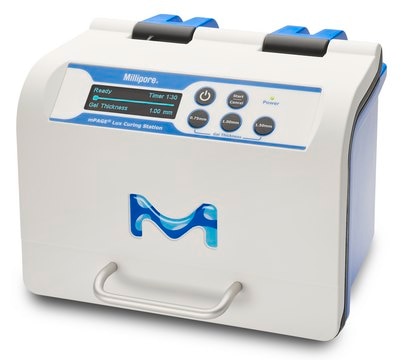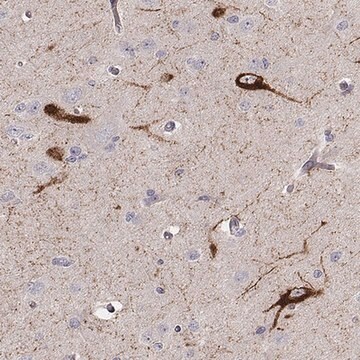MAB356
Anti-Substance P Antibody, pain, clone NC1
culture supernatant, clone NC1, Chemicon®
Synonym(s):
Anti-Hs.2563, Anti-NK2, Anti-NKNA, Anti-NPK, Anti-TAC2
Sign Into View Organizational & Contract Pricing
Select a Size
All Photos(1)
Select a Size
Change View
About This Item
UNSPSC Code:
12352203
eCl@ss:
32160702
NACRES:
NA.41
Recommended Products
biological source
rat
Quality Level
antibody form
culture supernatant
antibody product type
primary antibodies
clone
NC1, monoclonal
species reactivity
human
species reactivity (predicted by homology)
mammals
manufacturer/tradename
Chemicon®
technique(s)
immunohistochemistry: suitable
isotype
IgG2a
Specificity
Reacts with COOH-terminal end of Substance P. No cross-reactivity to Leu- or Met- enkephalin, somatostatin or beta-endorphin. Eledoisin 5%.
Immunogen
Substance P conjugated to BSA.
Application
1:100 - 1:200 by immunohistochemistry on human brain.
Optimal working dilutions must be determined by end user.
Optimal working dilutions must be determined by end user.
Detect Substance P using this Anti-Substance P Antibody, pain, clone NC1 validated for use in IH.
Physical form
Lyophilized Supernatant, preservative free.
Storage and Stability
Lyophilized antibody can be kept at 2-8°C for up to 3 months and should be kept at -20°C for long term storage. Reconstitute with 100μL sterile DI water. Maintain at -20°C in undiluted aliquots for up to 6 months. Avoid repeated freeze/thaw cycles.
Other Notes
Concentration: Please refer to the Certificate of Analysis for the lot-specific concentration.
Legal Information
CHEMICON is a registered trademark of Merck KGaA, Darmstadt, Germany
Not finding the right product?
Try our Product Selector Tool.
signalword
Warning
hcodes
Hazard Classifications
Eye Irrit. 2 - Skin Irrit. 2
Storage Class
11 - Combustible Solids
wgk_germany
WGK 2
Certificates of Analysis (COA)
Search for Certificates of Analysis (COA) by entering the products Lot/Batch Number. Lot and Batch Numbers can be found on a product’s label following the words ‘Lot’ or ‘Batch’.
Already Own This Product?
Find documentation for the products that you have recently purchased in the Document Library.
Tibor Z Veres et al.
American journal of respiratory cell and molecular biology, 37(5), 553-561 (2007-06-30)
Neuroimmune interactions play a critical role in the pathogenesis of asthma. Symptoms like wheezing and cough have been attributed to neural dysregulation, whereas sensitization and the induction of allergic inflammation have been linked with the activity of dendritic cells. Neuropeptides
Hypoalgesia in mice with a targeted deletion of the tachykinin 1 gene.
Zimmer, A; Zimmer, AM; Baffi, J; Usdin, T; Reynolds, K; Konig, M; Palkovits, M; Mezey, E
Proceedings of the National Academy of Sciences of the USA null
Andrew P Ray et al.
Pharmacology, biochemistry, and behavior, 94(1), 211-218 (2009-08-25)
Research on the mechanisms of emesis has implicated multiple neurotransmitters via both central (dorsal vagal complex) and peripheral (enteric neurons and enterochromaffin cells) anatomical substrates. Taking advantage of advances in receptor-specific agonists, and utilizing Fos expression as a functional activity
Elena V Sviderskaya et al.
FASEB journal : official publication of the Federation of American Societies for Experimental Biology, 23(9), 3179-3192 (2009-05-19)
Stem cells, that is, cells that can both reproduce themselves and differentiate into functional cell types, attract much interest as potential aids to healing and disease therapy. Embryonic neural crest is pluripotent and generates the peripheral nervous system, melanocytes, and
Liang Han et al.
Nature neuroscience, 21(3), 324-328 (2018-02-07)
Asthma, accompanied by lung inflammation, bronchoconstriction and airway hyper-responsiveness, is a significant public health burden. Here we report that Mas-related G protein-coupled receptors (Mrgprs) are expressed in a subset of vagal sensory neurons innervating the airway and mediates cholinergic bronchoconstriction
Our team of scientists has experience in all areas of research including Life Science, Material Science, Chemical Synthesis, Chromatography, Analytical and many others.
Contact Technical Service









